Peloponnes
Author: Bernd Eisenstein
Publisher: Iron Games
Year: 2009
review by

| x |
|
|
|
|
|
|
|
|
|
|
|
|
|
|
|
|
|
|
|
|
|
|
|
|
|
|
|
|
|
|
|
|
|
|
|
|
|
|
|
|
|
|
|
|
|
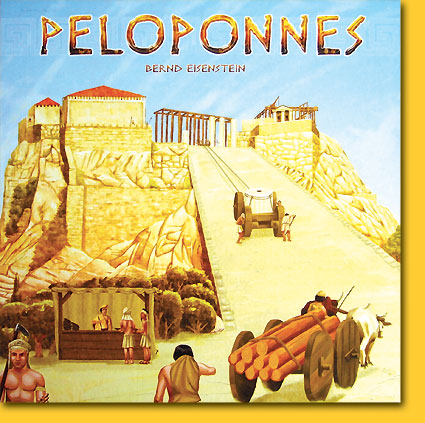 |
'Peloponnese, seat of the Gods', the rulebook of Peloponnese begins. The gods?! Weren't they located on the Olympos, far away in the northeast of Greece? Did they move without notifying us?
Anyway, each player represents a Peloponnesian civilisation that he aims to develop, and the absence or presence of the gods is of no importance to us. Players erect buildings, and farm and culture the land, and the population steadily increases.
In the process, players have to avoid over- or underpopulation by maintaining the balance between the population density on one hand, and the available buildings and land on the other hand. On top of that, nature has a couple of nasty disasters in store for us that we have to get through. The player that manages to develop the most wealthy, sustainable civilisation wins the game!
|
| x |
|
|
|
|
|
|
|
|
|
|
|
|
|
|
|
|
|
|
|
|
|
|
|
|
|
|
|
|
|
|
|
|
|
|
|
|
|
|
|
|
|
|
|
|
|
|
Each player receives a civilisation tile depicting his starting conditions (population, money, resources), and a board with tracks to mark his resources. During the game, the civilisations are expanded with building tiles, positioned left to the starting tile, and land tiles, on the right of the starting tile. In the income phase, players receive income for their tiles: wood, stone or food. The buildings often have an additional feature, for example they protect the owner from a disaster. Additionally, victory points are awarded for all tiles at the end of the game.
|
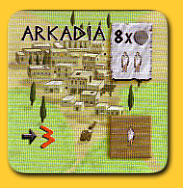 |
| x |
|
|
|
|
|
|
|
|
|
|
|
|
|
|
|
|
|
|
|
|
|
|
|
|
|
|
|
|
|
|
|
|
|
|
|
|
|
|
|
|
|
|
|
|
|
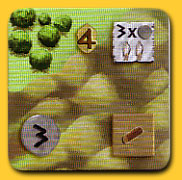 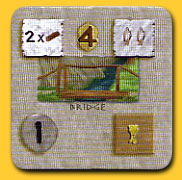 |
|
Every round, five new building- and land tiles are auctioned. Each tile depicts a minimum bid; in player order, all players place their bid next to the desired tile. If a player wants a tile that has already been claimed by another player, he has to outbid him. The outbid player removes his chit and money, and he may transfer it to a tile that has not been claimed yet. Of course his bid has to match the minimum bid for this tile! He may not raise his bid. If he chooses not to bid on another tile he may take his money plus one extra from the supply, and he does not receive a new tile this round.
|
| x |
|
|
|
|
|
|
|
|
|
|
|
|
|
|
|
|
|
|
|
|
|
|
|
|
|
|
|
|
|
|
|
|
|
|
|
|
|
|
|
|
|
|
|
|
|
|
After all players have placed a bid, everybody adds his new tile to his civilisation. Buildings need to be constructed first, with wood or stone. There is an additional placement rule for land tiles: they may only be positioned next to a tile that yields the same resource. If a tile yields multiple resources, at least one of them has to overlap: next to a wood/food tile, no stone tile can be placed, but it is allowed to place a stone/food tile (food overlaps) or a stone/wood tile (wood overlaps). In addition to the income the players collect every round, most buildings and land tiles also yield a one-time increase in population.
|
|
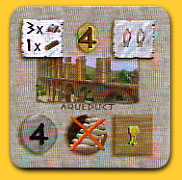 |
| x |
|
|
|
|
|
|
|
|
|
|
|
|
|
|
|
|
|
|
|
|
|
|
|
|
|
|
|
|
|
|
|
|
|
|
|
|
|
|
|
|
|
|
|
|
|
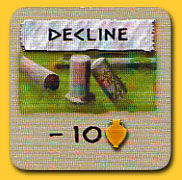  |
|
After each round two disaster chits are drawn. As soon as three identical chits have been drawn, the corresponding disaster takes place immediately. Everybody has to pay the required amount of resources, money or population. During the game, all five disasters are bound to occur: there is no escape!
|
| x |
|
|
|
|
|
|
|
|
|
|
|
|
|
|
|
|
|
|
|
|
|
|
|
|
|
|
|
|
|
|
|
|
|
|
|
|
|
|
|
|
|
|
|
|
|
|
And as if the disasters alone are not bad enough: two tiles depict a 'supply round' symbol, and as soon as these tiles are revealed, everybody has to feed his population by handing in the corresponding amount of food. Everybody that cannot be fed will not survive!
|
| x |
|
|
|
|
|
|
|
|
|
|
|
|
|
|
|
|
|
|
|
|
|
|
|
|
|
|
|
|
|
|
|
|
|
|
|
|
|
|
|
|
|
|
|
|
|
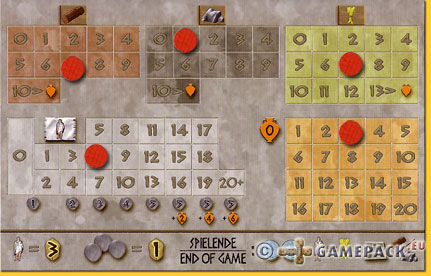 |
|
The game lasts eight rounds, and then the score is determined. The buildings and land tiles score as many points as depicted on the tile. This total is compared to the number of points for the population: three points per surviving person. The lower of these two numbers is the final score.
|
| x |
|
|
|
|
|
|
|
|
|
|
|
|
|
|
|
|
|
|
|
|
|
|
|
|
|
|
|
|
|
|
|
|
|
|
|
|
|
|
|
|
|
|
|
|
|
| x |
|
|
|
|
|
|
|
|
|
|
|
|
|
|
|
|
|
|
|
|
|
|
|
|
|
|
|
|
|
|
|
|
|
|
|
|
|
|
|
|
|
|
|
|
|
| x |
|
|
|
|
|
|
|
|
|
|
|
|
|
|
|
|
|
|
|
|
|
|
|
|
|
|
|
|
|
|
|
|
|
|
|
|
|
|
|
|
|
|
|
|
|
 |
|
|
|
|
|
|
|
|
|
|
|
|
|
|
|
|
|
|
|
|
|
|
|
|
|
|
|
|
|
|
|
|
|
|
|
|
|
|
|
|
|
|
The nicest part of Peloponnes is the auction. Not only should players consider the minimum bid of the tile they desire, but in case they are outbid, the bid must also suffice to claim the second choice-tile.
|
| x |
|
|
|
|
|
|
|
|
|
|
|
|
|
|
|
|
|
|
|
|
|
|
|
|
|
|
|
|
|
|
|
|
|
|
|
|
|
|
|
|
|
|
|
|
|
|
It is not advisable to miss out on the auction too often; the tiles are not only important for the final score, but they also supply the necessary resources. Especially the five disasters are a heavy burden on the supply. An earthquake for example takes one stone and one wood for every building tile in the civilisation. If a player cannot pay for his buildings, he has to discard them! And should the supply rooms exceed 10 resources, the remaining resources are marked on the 'luxury goods' track. Luxury goods may be exchanged 2:1 into any resource or money at any time. This is a good solution to prevent that players end up with useless surplus of one resource, while they desperately lack another.
|
|
 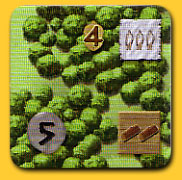 |
| x |
|
|
|
|
|
|
|
|
|
|
|
|
|
|
|
|
|
|
|
|
|
|
|
|
|
|
|
|
|
|
|
|
|
|
|
|
|
|
|
|
|
|
|
|
|
 |
The disasters are a nice addition to the game; because every disaster requires different resources, it forces players to construct a balanced civilisation right from the start. But the last two disasters are disproportionally hard: there is no opportunity to repair the damage, and immediately afterwards the players have to feed their population for the last time. Well, that is not easy after two disasters! Especially the drought, where 1/3 of the food supply is eradicated, is nasty. Or the plague that kills 1/3 of your population: goodbye victory points...
|
|
|
|
|
|
|
|
|
|
|
|
|
|
|
|
|
|
|
|
|
|
|
|
|
|
|
|
|
|
|
|
|
|
|
|
|
|
|
|
|
|
|
|
|
|
|
|
Because all resources are required in the game, as well as a large population, which is coupled to the amount of money players receive each round, everybody will try to build a balanced civilisation. It is therefore not necessary to split the score into building/land tiles versus population; a total score for tiles plus population would also suffice.
|
|
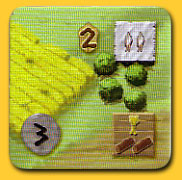  |
This segregation unnecessarily complicates matters, while Peloponnes is otherwise such a straightforward game. It offers a surprising amount of fun and depth in less than an hour.
© 2010 Barbara van Vugt
Peloponnes, Bernd Eisenstein, Iron Games, 2009 - 1 to 5 players, 10 years and up, 45-60 minutes
|
  |
|
|
|
|
|
|
|
|
|
|
|
|
|
|
|
|
|
|
|
|
|
|
|
|
|
|
|
|
|
|
|
|
|
|
|
|
|
|
|
|
|
  |
|
|
|
|
|
|
|
|
|
|
|
|
|
|
|
|
|
|
|
|
|
|
|
|
|
|
|
|
|
|
|
|
|
|
|
|
|
|
|
|
|
  |
|
|
|
|
|
|
|
|
|
|
|
|
|
|
|
|
|
|
|
|
|
|
|
|
|
|
|
|
|
|
|
|
|
|
|
|
|
|
|
|
|
  |
|
|
|
|
|
|
|
|
|
|
|
|
|
|
|
|
|
|
|
|
|
|
|
|
|
|
|
|
|
|
|
|
|
|
|
|
|
|
|
|
|
  |
Swift development game with some luck |
| x |
|
|
|
|
|
|
|
|
|
|
|
|
|
|
|
|
|
|
|
|
|
|
|
|
|
|
|
|
|
|
|
|
|
|
|
|
|
|
|
|
|
|
|
|
|
| x |
|
|
|
|
|
|
|
|
|
|
|
|
|
|
|
|
|
|
|
|
|
|
|
|
|
|
|
|
|
|
|
|
|
|
|
|
|
|
|
|
|
|
|
|
|
 |
|
|
|
|
|
|
|
|
|
|
|
|
|
|
|
|
|
|
|
|
|
|
|
|
|
|
|
|
|
|
|
|
|
|
|
|
|
|
|
|
|
 |
|
|
|
|
|
|
|
|
|
|
|
|
|
|
|
|
|
|
|
|
|
|
|
|
|
|
|
|
|
|
|
|
|
|
|
|
|
|
|
|
|
| x |
|
|
|
|
|
|
|
|
|
|
|
|
|
|
|
|
|
|
|
|
|
|
|
|
|
|
|
|
|
|
|
|
|
|
|
|
|
|
|
|
|
|
|
|
|
 |
|
|
|
|
|
|
|
|
|
|
|
|
|
|
|
|
|
|
|
|
|
|
|
|
|
|
|
|
|
|
|
|
|
 |
|
|
|
|
|
|
|
|
|
|
|
|
|
|
|
|
|
|
|
|
|
|
|
|
|
|
|
|
|
|
|
|
|
|
|